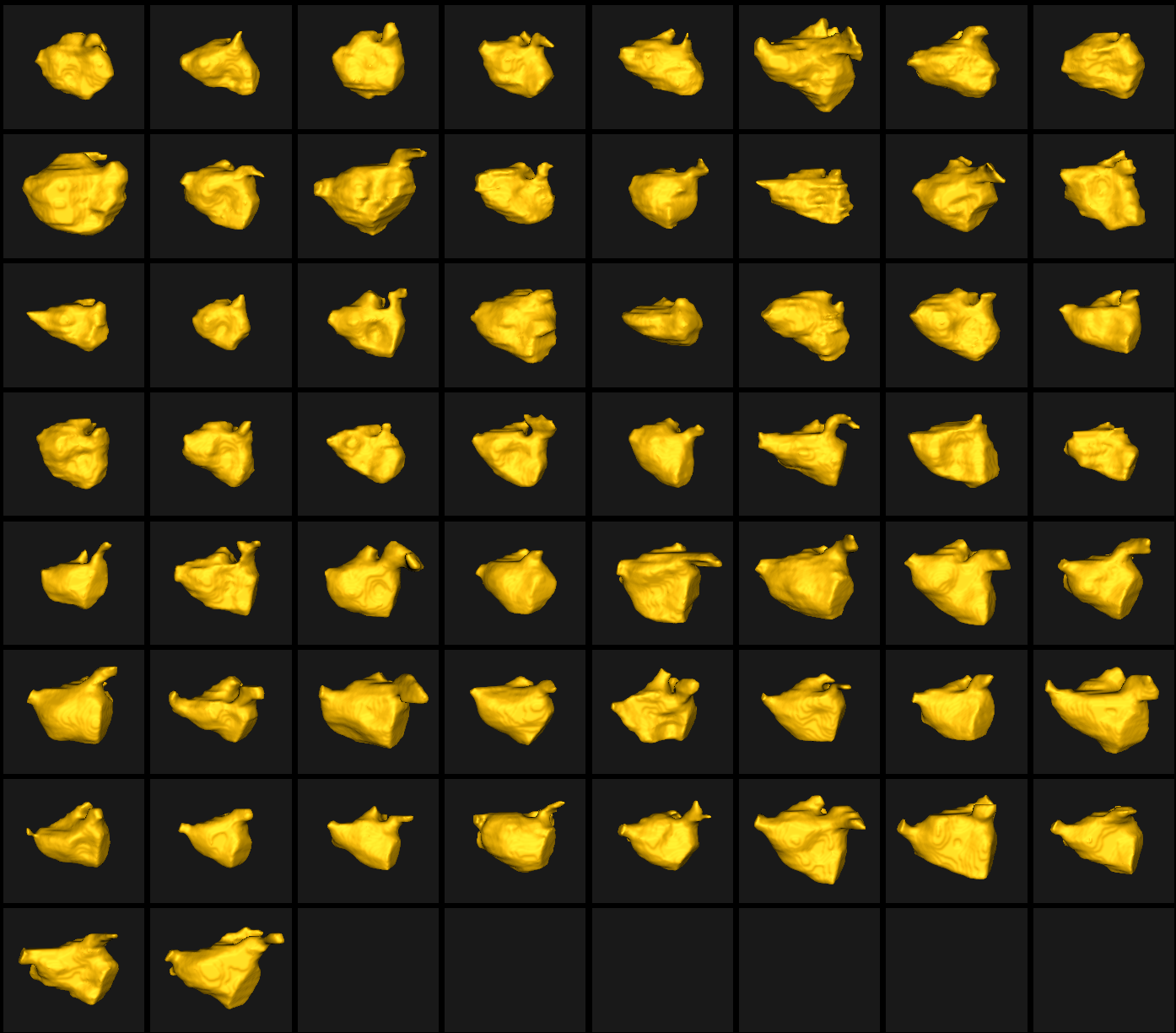Left Atrium: Shape Model from Segmentations
What is the Use Case?
The left_atrium use case demonstrates using ShapeWorks tools to perform the following.
- Build a shape model where shapes are given as binary segmentations
- Groom a dataset that contains both shapes (segmentations) and their corresponding imaging data (e.g., MRI) (when
--groom_imagestag is used) - Showcase both single-scale and multi-scale optimization for particles optimization
Grooming Steps
This is how the segmentations in the dataset look before grooming.Here it can been seen that the atriums have random centers andn orientations.
The grooming stage entails rigid transformations to align samples for groupwise modeling and analysis. It also changes the origin, voxel size, image size, orientation, etc. of the shape data. Grooming can be done with imaging data (CT/MRI) so that it is carried through each grooming step and with the shapes so that is remains in alignemtn and can be used for subsequent analysis. Here are the grooming steps:
- Isotropic Resampling: Both binary segmentations in
left_atrium/segmentations/and their corresponding images inleft_atrium/images/are resampled to have an isotropic voxel spacing. - Centering: Segmenations and images are translated to have an origin at (0,0,0).
- Apply Padding: Segmentations that touch the image boundary will have an artificial hole at that intersection. Segmentations and images are padded by adding a user-defined number of voxels along each image direction (rows, cols, and slices) to avoid introducing artificial holes.
- Center-of-Mass Alignment: This translational alignment step is performed before rigidly aligning the samples to a shape reference. This factors out translations to reduce the risk of misalignment and allow for a medoid sample to be automatically selected as the reference for rigid alignment.
- Reference Selection: The reference is selected by first computing the mean (average) distance transform of the segmentations, then selecting the sample closest to that mean (i.e., medoid).
- Rigid Alignment: All of the segmentations and images are then aligned to the selected reference using rigid alignment, which factors out the rotation and remaining translation. The alignment parameters are computed based on aligning segmentations and then applied to their corresponding images.
- Bounding Box: The smallest region which fits all of the samples is found.
- Cropping: The segmentations are cropped to the size of the bounding box.
- Distance Transform: Finally, the signed distance transform is computed, and the dataset is now ready for the optimize phase.
Here are the resulting groomed ditsance transforms.The left atriums are now centred and aligned ready to be sent to the optimizer.

Relevant Arguments
--use_subsample --num_subsample --skip_grooming --groom_images --use_single_scale --mesh_mode --tiny_test
Optimization Parameters
The python code for the use case calls the optimize command of ShapeWorks which requires the parameters of the optimization to be specified in a python dictionary. Please refer to Parameter Dictionory in Python for more details.
Below are the default optimization parameters when running this use case.
{
"number_of_particles" : 512,
"use_normals": 0,
"normal_weight": 10.0,
"checkpointing_interval" : 200,
"keep_checkpoints" : 0,
"iterations_per_split" : 4000,
"optimization_iterations" : 4000,
"starting_regularization" : 1000,
"ending_regularization" : 10,
"recompute_regularization_interval" : 2,
"domains_per_shape" : 1,
"relative_weighting" : 10,
"initial_relative_weighting" : 0.1,
"procrustes_interval" : 1,
"procrustes_scaling" : 1,
"save_init_splits" : 0,
"verbosity" : 0,
"use_shape_statistics_after": 128
}
Analyzing Shape Model
Once the python code runs the optimization, the files are saved in the Output folder after which ShapeWorks Studio is launched from the python code to analyze the model.
Single-Scale Optimization
Here is the mean shape of the optimized shape mode using single-scale optimization.

Here is a video showing the shape modes of variation (computed using principal component analysis - PCA) of the left atrium dataset using single-scale optimization.
Multi-Scale Optimization
Here is the mean shape of the optimized shape mode using multi-scale optimization.

Here is a video showing the shape modes of variation (computed using principal component analysis - PCA) of the left atrium dataset using multi-scale optimization.